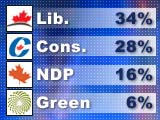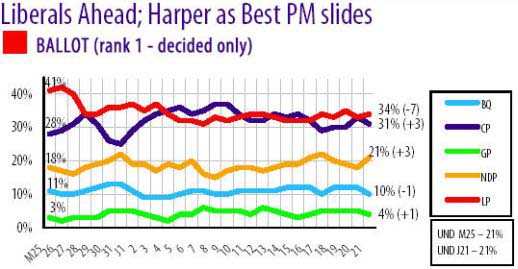 |
|
|
With fewer than six days to go before election day, support for the Conservative Party has taken a dramatic dip. The most significant change is in Ontario where — according to the latest Ipsos-Reid poll — the Liberals are surging, up eight points to 42 per cent, versus 30 per cent for a Conservative Party in steep decline, down an astounding eight points. The NDP remains firm at 20 per cent, with protest support for the Green Party stuck at six per cent.
 |
As for who will govern the country, the race is still too close to call.
According to Ipsos-Reid’s seat projection model, if a vote were held tomorrow, the Conservatives would have a potential of 110-114 seats, the Liberals would have a potential of 107-111 seats, the NDP a potential of 19-23 seats, and the Bloc Québécois a potential of 64-68 seats.
The Ipsos-Reid results are not vastly different from the numbers reported this morning by SES Canada Research, whose overnight tracking poll conducted for the CPAC network shows the Liberals ahead at 34% among the electorate, with the Conservatives trailing at 31%, the NDP up a notch to 21%, and the Greens garnering 10% support.
Liberal Support Climbs in the Final Week of the Campaign

In addition to the CPAC-SES poll results reported above, SES reports a dramatic decline in support for Stephen Harper as Prime Minister, to only 22%, while Paul Martin’s results have remained fairly steady at a hardly gratifying 28%. Jack Layton trails badly at only 10% support for Best PM.
Tories Falter Elsewhere, But Remain Strong in B.C.
The headline above doesn’t tell the whole story.
While it’s true that support for the Conservative Party in British Columbia remains strong (as can be seen in the graph below) at 36% province-wide, in the city of Vancouver the Conservatives are running a distant third to both the New Democrats and the Liberals.
 |
Other findings of the Mustelgroup polling of British Columbians include:
- Men tend to support the Conservative Party, whereas women are divided between the Tories and the NDP (the Liberal Party ranks third among women);
- Conservatives lead among every major age group with the exception that those 35-54 years are divided between the Conservatives and the NDP;
- Conservative and NDP supporters are firmer in their intentions than Liberal supporters, suggesting that Liberal support is more vulnerable to erosion;
- 50% believe that the votes of British Columbians will matter more than usual in this election than in the past;
- On the issue of tax cuts, voters prefer to maintain taxes and government services at the current level (49%), than reduce taxes and government services (26%), or increase taxes and services (16%), with 9% undecided.
While the NDP and the Liberal Party are competing for support in the City of Vancouver (37% and 39% respectively), the Conservatives lead outside the City (43%), with significant support in the suburbs and rural B.C.
The real insight that may be derived from the Mustelgroup poll (and from the Ipsos-Reid poll, as well) concerns the growing urban vs suburban / rural split. Major cities across Canada — including Vancouver, Saskatoon, Regina, Winnipeg, Toronto and Hamilton — express almost overwhelming support for the New Democrats or the Liberals, whereas outside of the major cities the populace is almost foresquare behind the Conservatives.
The results above show a severe and disturbing divide among Canadians, and indicate that most suburban and rural Canadians feel that issues of importance to them are simply not being addressed by the centre-left parties in the Canadian political milieu.
Significant moves will have to be made by the centre-left parties before the next election to address this divide, or Canada risks becoming a nation rent by a new and deepening internal conflict.